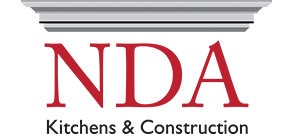Flexible lighting for your kitchen is essential to handle the many moods and functions of this busy room.
The best kitchen designs incorporate smart lighting schemes that give you maximum flexibility over how this busy work and gathering space is illuminated. While there is no single “best” way to light the kitchen, there are three types of lighting systems you’ll want to work into your remodel plan:
- General/ambient lighting. Your kitchen should have ample general light (also known as “ambient” light) available so that working in it can be done safely and enjoyably. If your design permits, a large window or skylight can be used to admit light into the kitchen during daylight hours, with artificial ambient light provided via ceiling lighting, such as recessed “high hats,” track lighting, or a single ceiling-mounted light fixture.
- Task Lighting. It’s important to light up areas where food preparation, cooking, cleanup, reading, doing homework and other counter-based tasks are performed. Task lighting is typically accomplished by small under-cabinet lights, spots, or hanging pendant fixtures placed about 30 to 36 inches above the island.
- Accent Lighting. Your lighting scheme should give you a way to draw attention to your kitchen’s aesthetic features – for example, your cabinets, appliances, or other flourishes. This kind of lighting is called “accent” lighting and can be accomplished in a number of different ways, like via over-cabinet lighting, spotlights, in-cabinet lighting, and even in-shelf lighting. The advent of low-voltage LED lighting systems has vastly increased the number of possibilities for this kind of kitchen
Layers of Light
Think of these three types of lighting – Ambient, Task, and Accent – as layers that can be blended together to suit whatever mood you want your kitchen to be in. Each “layer” should be on its own lighting circuit so that it can be independently activated/de-activated, and each should be controlled by dimmers so that the intensity of each layer can be continuously varied.
Ambient Lighting Choices
Getting a baseline estimate for the amount of ambient light your kitchen requires starts with some simple math. A formula recommended by the American Lighting Association is that you should multiply the square footage in your kitchen by 1.5 to obtain the wattage. So, for example, if your floor space is 100 square feet, you’d need a total of 150 watts of ambient lighting.
Note, however, that this is just a baseline. The colors in your kitchen matter a lot in this equation: if your cabinets, countertops, and floor are dark, they’ll absorb more light, so you’ll require more wattage. Conversely, you might need less if a window and/or skylight can be relied upon for ambient light.
In terms of the fixtures chosen to deliver ambient light, popular choices are recessed ceiling lights (sometimes called “high hats”), track lighting (less popular today), monorail-style lights, and “in plaster” embedded LED strips.
Task Lighting Choices
Task lighting lets you focus illumination on the individual work areas of your kitchen, such as your sink, cooktop, and countertop areas. Under-cabinet lighting systems are perfect for these spaces and readily available. Some can be easily installed as DIY projects, whereas others are probably best installed by a licensed electrician.
For task lighting to light up standalone counter islands, one or more hanging pendant fixtures can be used to brighten the island surface, while serving as an expressive design focal point.
Accent Lighting Choices
The entire function of accent lighting is to draw attention to the best features of your kitchen. In this sense, this lighting layer is less functional than the other two, but that doesn’t mean accent lighting isn’t important. Proper use of accent lighting will turn an “okay-looking” kitchen into a “wow” kitchen, which will be pleasing to you and—if you intend to sell your home, a plus for your home’s resale value.
Today, with the advent of a multitude of new generation of high-intensity, low-voltage, miniature lighting components, you can go wild with accent lighting. You can use them for over-cabinet lighting, in-cabinet lighting, and even in-drawer lighting. Be aware, however, that it’s often much easier to install these more elaborate lighting systems before and during your cabinetry installation, rather than after the fact (which is why it’s good to think about them now, rather than later).
Your kitchen designer will light the right path for your needs and budget
Today, there have never been so many attractive, energy-efficient, and customizable lighting options to make your kitchen an exciting, beautiful, enjoyable space. But please don’t feel overwhelmed by these choices. An excellent designer will consult with you and your budget and recommend which options will work best. So please don’t hesitate to get in touch with NDA Kitchens. There’s nothing more illuminating than talking about kitchen lighting—and our consultations are always free.


